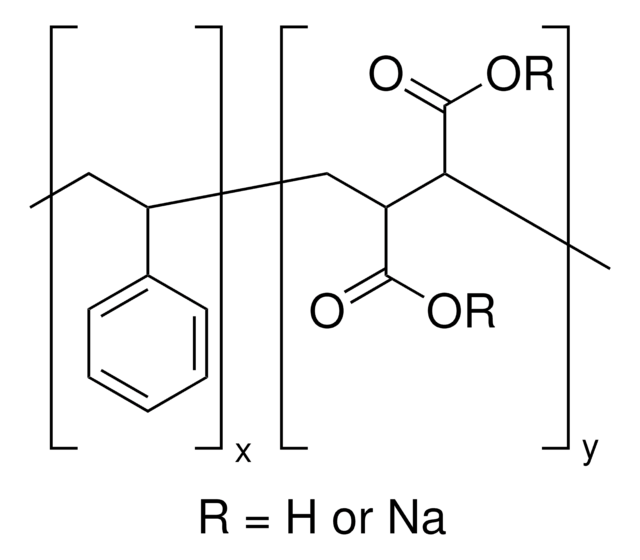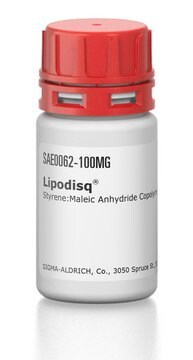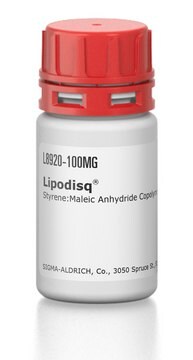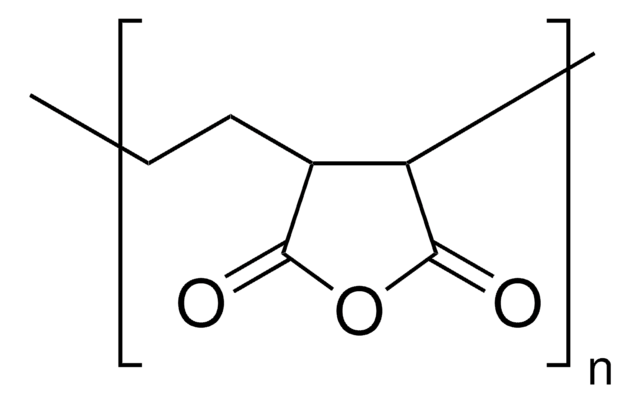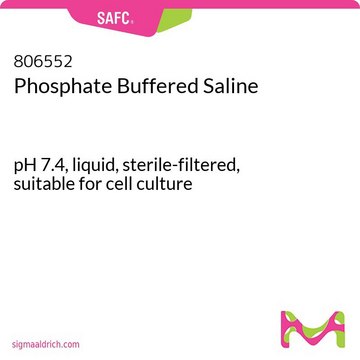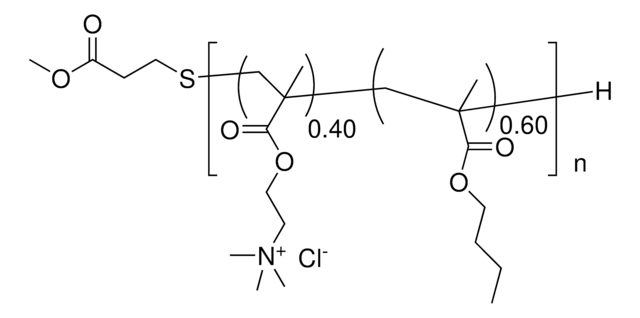L9170
Lipodisq®
Styrene: Maleic Anhydride Copolymer 3:1, Pre-hydrolyzed, powder, from synthetic
Iniciar sesiónpara Ver la Fijación de precios por contrato y de la organización
About This Item
UNSPSC Code:
12352202
NACRES:
NA.26
Productos recomendados
biological source
synthetic
Quality Level
assay
98-100%
form
powder
mol wt
9500 Da
storage condition
(Keep container tightly closed in a dry and well-ventilated place
Keep in a dry place)
storage temp.
room temp
¿Está buscando productos similares? Visita Guía de comparación de productos
General description
Research area: Cell Structure
Lipodisq® polymers contain styrene and maleic acid monomer units. This product is the pre-hydrolyzed form of the SMA polymer, with styrene and maleic acid monomers. These polymer-lipid complexes are mainly generated by detergent-free methods.
Functional pH range: 6.0 - 9.0
Lipodisq® polymers contain styrene and maleic acid monomer units. This product is the pre-hydrolyzed form of the SMA polymer, with styrene and maleic acid monomers. These polymer-lipid complexes are mainly generated by detergent-free methods.
Functional pH range: 6.0 - 9.0
Application
Lipodisq® reagents are novel polymers derived from styrene and maleic acid. Lipodisq polymers are capable of forming nanosized lipid-based discoidal particles capable of incorporating membrane proteins. The Lipodisq technology can solubilize commonly used lipids such as dimyristoylphosphatidylcholine (DMPC) without the use of detergents. In general, Lipodisq polymers are potentially useful in mitigating the use of detergents for the solubilization of membrane proteins. Lipodisqs typically have a diameter of 9-10 nm at pH 7.4.
Legal Information
Lipodisq is a registered trademark of Malvern Cosmeceutics Limited
Related product
Referencia del producto
Descripción
Precios
Storage Class
11 - Combustible Solids
wgk_germany
WGK 3
flash_point_f
Not applicable
flash_point_c
Not applicable
Certificados de análisis (COA)
Busque Certificados de análisis (COA) introduciendo el número de lote del producto. Los números de lote se encuentran en la etiqueta del producto después de las palabras «Lot» o «Batch»
¿Ya tiene este producto?
Encuentre la documentación para los productos que ha comprado recientemente en la Biblioteca de documentos.
Los clientes también vieron
Indra D Sahu et al.
Biochemistry, 52(38), 6627-6632 (2013-08-30)
Pulsed EPR DEER structural studies of membrane proteins in a lipid bilayer have often been hindered by difficulties in extracting accurate distances when compared to those of globular proteins. In this study, we employed a combination of three recently developed
Detergent-Free Formation and Physicochemical Characterization of Nanosized Lipid-Polymer Complexes: Lipodisq
Orwick MC, et al.
Angewandte Chemie (International ed. in English), 51(19), 4653-4657 (2012)
Juan F Bada Juarez et al.
Chemistry and physics of lipids, 222, 51-58 (2019-05-19)
Lipodisq™ nanoparticles have been used to extract surface lipids from the cuticle of two strains (wild type, N2 and the bacteria-resistant strain, agmo-1) of the C. elegans nematode without loss of viability. The extracted lipids were characterized by thin layer
Juan Francisco Bada Juarez et al.
Biochimica et biophysica acta. Biomembranes, 1862(3), 183152-183152 (2019-12-18)
Dopamine receptors (DRs) are class A G-Protein Coupled Receptors (GPCRs) prevalent in the central nervous system (CNS). These receptors mediate physiological functions ranging from voluntary movement and reward recognition to hormonal regulation and hypertension. Drugs targeting dopaminergic neurotransmission have been
Maria Lyngaas Torgersen et al.
Journal of biomedical nanotechnology, 16(4), 419-431 (2020-09-25)
Many promising pharmaceutically active compounds have low solubility in aqueous environments and their encapsulation into efficient drug delivery vehicles is crucial to increase their bioavailability. Lipodisq nanoparticles are approximately 10 nm in diameter and consist of a circular phospholipid bilayer
Nuestro equipo de científicos tiene experiencia en todas las áreas de investigación: Ciencias de la vida, Ciencia de los materiales, Síntesis química, Cromatografía, Analítica y muchas otras.
Póngase en contacto con el Servicio técnico